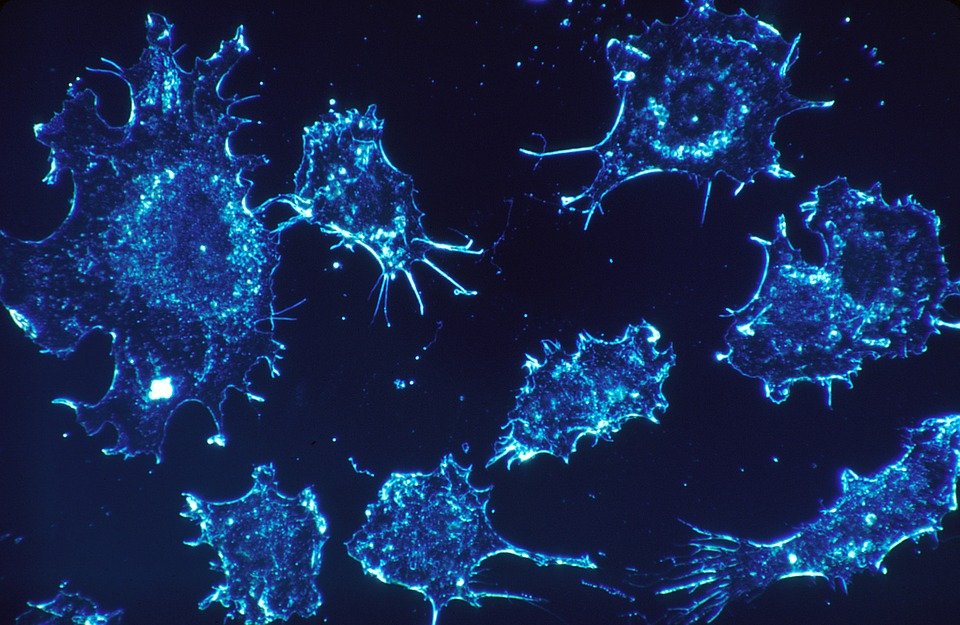
I've already talked about the difference between the innate and adaptive immune system and then went on to explain how the adaptive immune system works. With all the posts about viruses, I failed to show you what the innate immune system actually is!
Sure, it’s mostly barriers like your skin and stuff like stomach acid and snot but there are also cells. So many cells. Granulocytes (neutrophils, eosinophils, and basophils), monocytes which differentiate into macrophages and dendritic cells, dendritic cells that don’t come from monocytes and natural killer cells (NK cells).
A whole fucking zoo of cells. Let’s get started.
The granulocytes are called granulocytes because they have a lot of granules. Seriously. Look at this eosinophil:

By Bobjgalindo
And where did the neutrophils, basophils, and eosinophils get their names from? Biologists are very creative. They named the cells after the acidity of the dye they can be stained with (neutrophils neutral, basophils basic and eosinophils acidic).
But what are their main functions?
Neutrophils like to do phagocytosis. They eat up pathogens that come from the outside, like bacteria and fungi. They’re also the main ingredient in pimples. Yum.
Basophils release histamine which helps induce the inflammatory response.
Eosinophils contain toxic proteins and free radicals (oxygen radicals are the reason you need antioxidants) to destroy parasitic infections (also tumor cells).
Macrophages also like to do phagocytosis. A lot.
New ones constantly differentiate out of monocytes (big cells in our blood). When they’re grown they wander from our blood into our body’s tissue and eat up bacteria, viruses, protozoa and the leftovers of dead cells that once belonged to our body. They can live for months and even years!
In contrary to the T-Killer cells, the NKs don’t remember. They react to every pathogen like it’s the first time they’ve ever seen it, even if it’s the 20th. They kill infected cells and tumor cells when those have antibodies attached to them or are missing MHC-1 which indicates an infection or mutation. @suesa
Myeloid (or “conventional”) dendritic cells differentiate out of monocytes, just like macrophages. They’re the immune system’s snitches.
Immature myeloid dendritic cells constantly absorb antigens (= foreign proteins) until they’re mature. And then, they present the structure of those antigens to T-cells, which are part of the adaptive immune system. The presentation allows T-cells to learn what the pathogens look like so they can react to it.
Plasmacytoid dendritic cells come from bone marrow stem cells. They react to a viral infection by producing a lot of chemicals that alarm the rest of the immune system to the presence of viruses.
You see, there is a lot going on in your body. You should be glad that it (usually) happens by itself and you don’t have to micromanage every single cell!
Source:
Lecture “Immunology – Innate Immune System” by Barbara Walch-Rückheim
Picture Credit:
First picture from pixabay.com
Eosinophil: By Bobjgalindo (Own work) [GFDL (http://www.gnu.org/copyleft/fdl.html) or CC BY-SA 4.0-3.0-2.5-2.0-1.0 (https://creativecommons.org/licenses/by-sa/4.0-3.0-2.5-2.0-1.0)], via Wikimedia Commons
Sketches by me
Got a scientific topic which you want to see as a story? Leave me a comment!
You want to support scientists on Steemit? You are a scientist on Steemit? Join the #steemSTEM channel on steemit.chat and connect with us!
STEM is an acronym for Science, Technology, Engineering and Math

